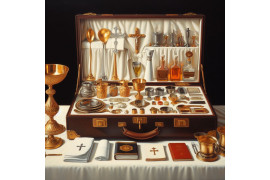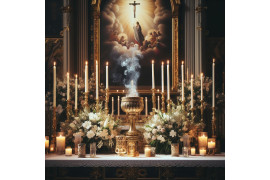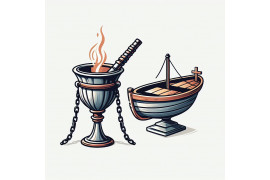Sanctuary lamps have a rich history spanning centuries and are an integral part of various religious traditions. These lamps hold significant symbolic and spiritual meaning, serving as a visual representation of the presence of the divine within sacred spaces. Different cultures and religions have their own unique practices surrounding sanctuary lamps, each with its own distinct rituals and customs. The historical significance of sanctuary lamps can be traced back to ancient times, where they were used in temples, churches, and other places of worship. These lamps often burn continuously, symbolizing the eternal light that guides believers on their spiritual journey.
Throughout the centuries, sanctuary lamps have provided a sense of peace and reverence for worshippers, creating a serene atmosphere within religious spaces. They serve as a reminder of the constant presence of God or higher powers in our lives. Join us as we delve into the fascinating world of sanctuary lamps, exploring their cultural significance and uncovering the diverse traditions associated with these timeless symbols.
Symbolism and Rituals Associated with Sanctuary Lamps in Religious Ceremonies
The sanctuary lamp holds significant symbolism and plays a vital role in various religious ceremonies. It represents the presence of a higher power or divine light, illuminating the sacred space. Lighting the sanctuary lamp is a common ritual that signifies reverence and devotion to the faith.
The flickering flame of the sanctuary lamp carries deep spiritual meaning. It symbolizes spiritual enlightenment, guiding believers on their journey towards a deeper connection with their faith. The eternal flame also serves as a reminder of God's everlasting presence and love.
In many religious traditions, the sanctuary lamp is placed near the high altar or tabernacle, where the reserved sacrament or blessed sacrament is kept. This placement emphasizes its significance as a visual representation of Christ's real presence in the Eucharist. The burning lamp acts as a constant reminder of this sacred presence even when Mass is not being celebrated.
During liturgical celebrations, such as Mass or other sacraments, the sanctuary lamp takes on additional importance. Its gentle glow creates an atmosphere of reverence and solemnity, enhancing worshipers' experience during these sacred moments. The flickering flame draws attention to the altar and focuses congregants' thoughts and prayers on God.
In some traditions, particularly those that follow presanctified liturgy or have perpetual adoration chapels, electric lights are used instead of candles for practical reasons. These electric lamps are designed to mimic candle flames while ensuring safety within enclosed spaces.
The lighting and extinguishing of the sanctuary lamp often follow specific rituals within each religious tradition. For example:
Lighting Ritual:
-
The priest approaches the sanctuary lamp before beginning any liturgical celebration.
-
Using a taper or candle flame, he carefully ignites the wick.
-
As he does so, he may recite prayers or blessings to sanctify this act.
-
Once lit, the sanctuary lamp remains illuminated throughout the celebration.
Extinguishing Ritual:
-
After the liturgical celebration, the priest approaches the sanctuary lamp once again.
-
He carefully extinguishes the flame, often by snuffing it out or covering it with a small cap or lid.
-
This act symbolizes the end of the sacred event and marks a transition back to ordinary time.
The symbolism and rituals associated with sanctuary lamps vary across different religious traditions, but their purpose remains consistent: to honor and acknowledge the divine presence in worship and prayer.
Purpose of the Sanctuary Lamp in Christian Churches
The sanctuary lamp holds significant meaning in Christian churches, serving a specific purpose related to the presence of the Blessed Sacrament. It is lit to symbolize and remind believers of Christ's eternal presence in the Eucharist. The burning lamp represents Jesus as the Light of the World.
Indicating the Presence of the Blessed Sacrament
One primary function of the sanctuary lamp is to indicate that the Blessed Sacrament, which refers to consecrated bread and wine representing Christ's body and blood, is present in the church. When lit, it signifies that Jesus is truly present in the tabernacle or a designated place within the church where consecrated hosts are kept.
Reminding Believers of Christ's Eternal Presence
The sanctuary lamp acts as a visual reminder for Christians that Jesus Christ is eternally present among them through his real presence in the Eucharist. Just as a lamp provides light in darkness, believers understand that Christ illuminates their lives with his divine presence and guidance.
Symbolizing Christ as the Light of the World
The burning sanctuary lamp also symbolizes Jesus as "the Light of the World." This symbolism draws from biblical references where Jesus describes himself as such. The light emitted by this lamp represents spiritual enlightenment, truth, and salvation brought by Jesus' teachings and sacrifice.
In addition to its symbolic significance, there are practical reasons behind keeping a continuously burning sanctuary lamp:
-
Visibility: The illuminated flame makes it easier for worshippers to locate where they can find and pay reverence to the Blessed Sacrament.
-
Adoration: The constant flame invites individuals to engage in adoration or prayerful contemplation before Christ's true presence.
-
Respect: Keeping a perpetually burning flame demonstrates respect for what Christians believe is truly God's presence among them.
While different Christian denominations may have variations in their practices regarding the sanctuary lamp, its fundamental purpose remains consistent across most churches. The lamp serves as a visual representation of Christ's eternal presence, reminding believers of his teachings and sacrifice.
Role of the Sanctuary Lamp in Jewish Synagogues
The sanctuary lamp, also known as the ner tamid or eternal light, plays a significant role in Jewish synagogues. It serves as a visual representation of God's eternal presence among His people. Let's delve into the importance and symbolism of the sanctuary lamp in Jewish worship.
Eternal Presence of God
In Jewish tradition, the sanctuary lamp is placed above or near the Ark that houses the Torah scrolls. This placement symbolizes God's everlasting covenant with His chosen people and signifies His constant presence within the synagogue. The flickering flame of the sanctuary lamp reminds worshippers that God is always watching over them.
Symbolism and Significance
The ner tamid holds deep symbolic meaning for Jews worldwide. Here are some key aspects to consider:
-
Continuity: The eternal light represents the continuity of Judaism throughout history, from ancient times to present-day.
-
Divine Guidance: It serves as a reminder that God provides guidance and wisdom to His people.
-
Covenant: The sanctuary lamp symbolizes God's covenant with Israel, emphasizing His faithfulness and commitment to His chosen nation.
-
Sacred Space: The presence of the ner tamid designates the synagogue as a sacred space, set apart for prayer and worship.
Historical Context
The use of an eternal light can be traced back to ancient times when it was an integral part of the Tabernacle and, later, Solomon's Temple in Jerusalem. The practice was continued in subsequent synagogues after their destruction.
Contemporary Practices
Today, most synagogues have a permanent sanctuary lamp that remains lit at all times, representing God's unwavering presence within their midst. However, there may be variations in design and placement based on different traditions or customs followed by different Jewish communities.
Cultural Significance
Beyond its religious significance, the sanctuary lamp also holds cultural value within Jewish communities:
-
Sense of Tradition: The presence of the ner tamid connects worshippers to their rich Jewish heritage and reinforces a sense of tradition.
-
Unity: It serves as a unifying symbol, reminding Jews worldwide that they are part of a larger community with shared beliefs and values.
-
Reverence for the Divine: The sanctuary lamp fosters an atmosphere of reverence and awe, encouraging worshippers to approach prayer with humility and respect.
Comparing Sanctuary Lamps in Lutheran and Catholic Churches
In both Lutheran and Catholic churches, sanctuary lamps play an important role. However, there are some slight differences in their design and placement. Let's take a closer look at how these lamps are used in each denomination.
Lutheran Churches: Simplicity with Purpose
In Lutheran churches, sanctuary lamps tend to be simpler and less ornate compared to those found in Catholic churches. The emphasis is on functionality rather than elaborate decoration. These lamps are typically placed near the altar or tabernacle as a symbol of the presence of Christ.
Key Points:
-
Simpler design compared to Catholic churches
-
Emphasis on functionality rather than ornamentation
-
Placed near the altar or tabernacle
Catholic Churches: Elaborate Rituals and Ornamentation
Catholic sanctuaries often have more elaborate rituals associated with lighting and maintaining the sanctuary lamp. The lamp itself is usually more ornate, reflecting the rich traditions of the Catholic faith. It serves as a reminder of Christ's perpetual presence in the Eucharist.
Key Points:
-
Elaborate rituals associated with lighting and maintaining the lamp
-
More ornate design compared to Lutheran churches
-
Symbolizes Christ's perpetual presence in the Eucharist
Similarities: Reverence Shared by Both Denominations
While there may be differences in design and ritual, both Lutheran and Catholic churches share a common emphasis on reverence.
Secular References and Symbolism of the Sanctuary Lamp
Outside religious contexts, sanctuary lamps can also be found in secular settings such as hospitals or funeral homes. In these non-religious environments, the sanctuary lamp takes on a different symbolism and meaning. It becomes more than just a religious symbol; it represents peace, hope, or remembrance.
In hospitals, the sanctuary lamp often serves as a calming presence for patients and their families. It creates an atmosphere of tranquility and serenity, providing a sense of comfort during times of illness or distress. The soft glow of the eternal light brings solace to those who are going through difficult times.
Similarly, in funeral homes, the sanctuary lamp holds significance in honoring and remembering the departed souls. It acts as a symbol of reverence and respect for the deceased. The flickering flame reminds mourners of the impermanence of life and offers them a space for reflection and remembrance.
The use of sanctuary lamps in these secular spaces reflects society's desire for a sacred environment that transcends religious boundaries. People seek solace and moments of contemplation regardless of their religious beliefs. The presence of a sanctuary lamp helps create an ambiance that is conducive to introspection and emotional healing.
While theologians may argue about the specific religious significance attached to sanctuary lamps within churches, outside these contexts, people appreciate their symbolic value without necessarily adhering to any particular faith tradition. They recognize the beauty and power behind these eternal flames that burn day and night.
In addition to hospitals and funeral homes, you might also come across sanctuary lamps in other secular settings like meditation centers or even certain public spaces designed for relaxation or reflection. These places aim to provide individuals with an opportunity to disconnect from the chaos of everyday life and reconnect with their inner selves.
To illustrate further:
-
Imagine walking into a meditation center where soft music plays in the background while you find yourself surrounded by candles flickering gently in dimly lit rooms. The sanctuary lamp, with its steady glow, would fit right into this serene atmosphere.
-
Consider a public park designed as a peaceful retreat from the hustle and bustle of the city. In one corner, you might find a small garden adorned with statues and a sanctuary lamp that invites visitors to sit and find solace in the tranquil surroundings.
Unveiling the Significance of the Sanctuary Lamp in Various Religions
We discovered that the purpose of the sanctuary lamp varies across different religions, from Christian churches to Jewish synagogues. While its primary function is to signify the presence of God or a divine presence, it also serves as a visual reminder for worshippers to focus their thoughts on spiritual matters.
Understanding the significance of sanctuary lamps in various religions can deepen our appreciation for these sacred objects. Whether you're interested in Christian traditions, Jewish customs, or comparing practices between Lutheran and Catholic churches, exploring this topic can provide valuable insights into different faiths.
If you have any further questions about sanctuary lamps or would like to delve deeper into religious symbolism and rituals, we encourage you to explore more articles on our website. Expand your knowledge and gain a better understanding of diverse cultures and belief systems through our informative content.
FAQs
What is the origin of sanctuary lamps?
Sanctuary lamps have been used since ancient times in various religious traditions. The practice originated from Jewish customs were an eternal flame burned outside the Holy of Holies in the Temple of Jerusalem. This tradition was later adopted by early Christians and continued throughout history.
Are all sanctuary lamps lit continuously?
While many sanctuary lamps are intended to burn continuously as a symbol of God's eternal presence, some may only be lit during specific religious services or occasions. The frequency and duration vary depending on individual religious practices and beliefs.
Can anyone light a sanctuary lamp?
The responsibility for lighting a sanctuary lamp often falls upon designated individuals within a religious community, such as priests, clergy members, or trained volunteers. However, some traditions may allow congregants or worshippers to participate in lighting or maintaining the lamp under certain circumstances.
What fuels are typically used for burning sanctuary lamps?
Traditionally, candles were commonly used to fuel sanctuary lamps. However, modern practices have also incorporated electric lights or oil lamps as alternatives. The choice of fuel may depend on factors such as safety, convenience, and adherence to specific religious guidelines.
Are sanctuary lamps found in all religious buildings?
Sanctuary lamps are most commonly associated with Christian churches and Jewish synagogues. However, their presence may vary depending on the denomination or sect within a particular religion. Other faiths or spiritual traditions may have different symbols or practices to represent the divine presence.



